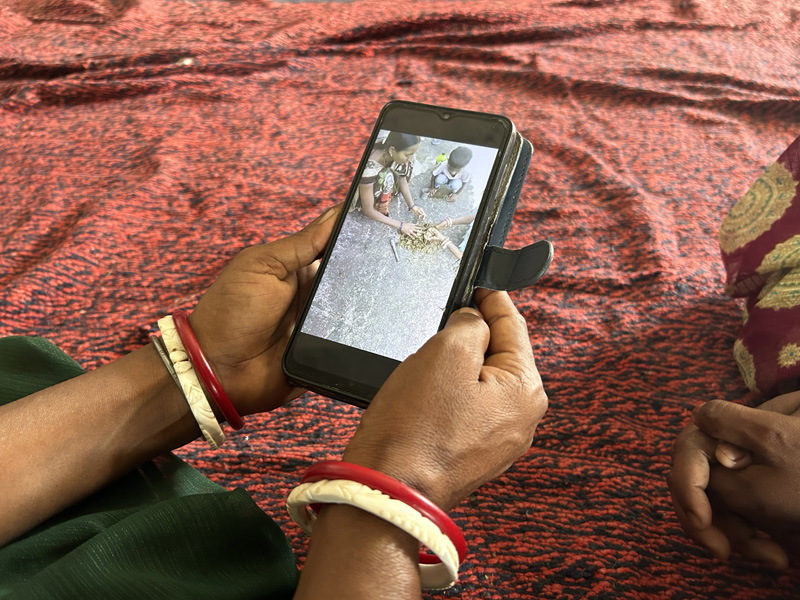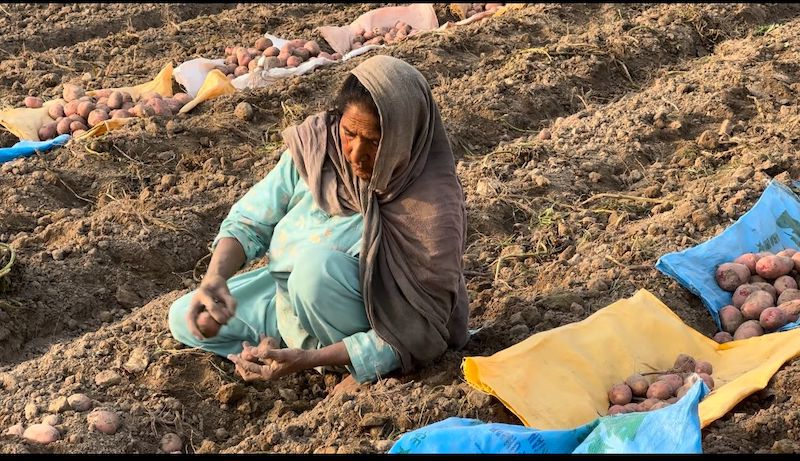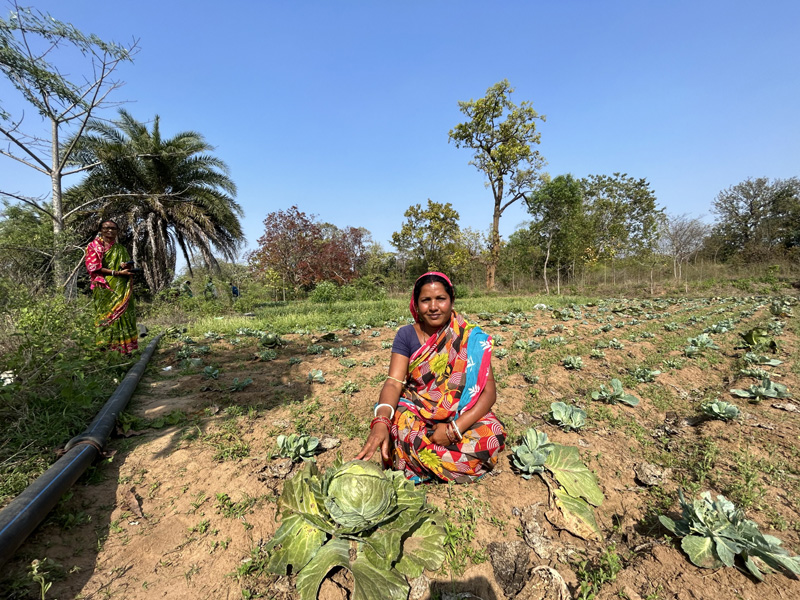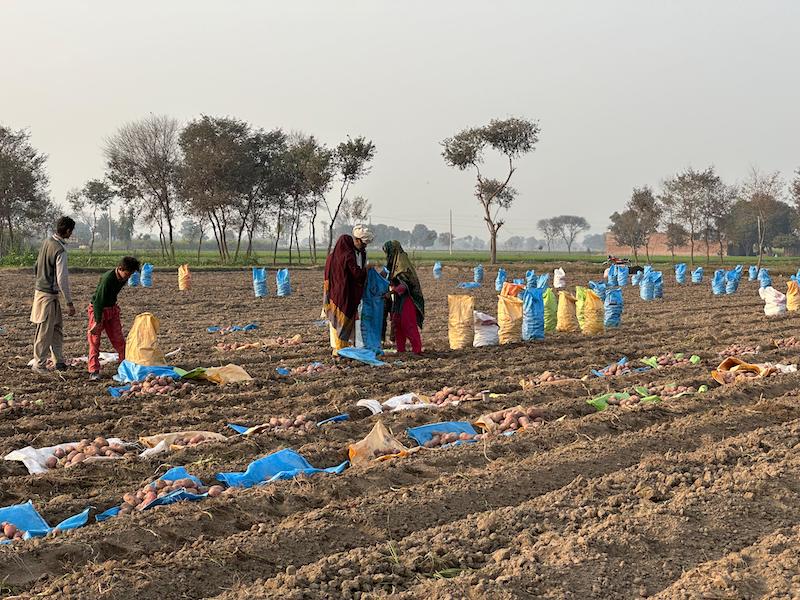 Climate Change
Climate Change
Women farmers in India and Pakistan look at agri-tech solutions to combat climate change, gender disparity
When Nirmala Mahanto first started farming on her in-laws' land in Keonjhar, India, she was taken aback by the back-breaking challenge of crop production. In this drought prone district of eastern India, water scarcity forces women like Nirmala to walk miles, lugging water to irrigate their lands. Agricultural cultivation in Keonjhar is mainly rainfed and as the water tables run low, any changes in rainfall have a bearing on food production.
In most drought prone regions such as these, men migrate to cities for better opportunities and women are left in charge of the farms to substantiate the family income and survive. But growing crops through traditional methods has not been easy, especially in those areas that have been impacted by climate change.
“When I first started tending to the fields, only 60% of the seeds I sowed turned into saplings, which meant huge losses in my field’s produce,” said Mahanto. “My family income was depleted, and I could hardly break even with what was left.”
Another complicating factor was the produce could not garner decent rates in the markets as middlemen kept the prices low.
Aisha Bibi, from the climate change affected Sahiwal region of Pakistan, has also struggled with the significant shifts in weather patterns that have affected her crops. Her family works as farm laborers and cultivates wheat, rice, sugarcane, and potatoes for wages.
“Our crop production has been impacted by unpredictable rains, hailstorms, heatwaves that has meant a cut in wages as well,” she said.
 Aisha Bibi in her potato farm in Sahiwal, Pakistan.
Aisha Bibi in her potato farm in Sahiwal, Pakistan.
With no stable income, Aisha Bibi struggles to sustain her family of eight.
Climate change has increased the burden on women farmers in both India and Pakistan and has made the issue of food production much more difficult. In the coming years this could have an exponential impact on the level of food production in these regions. As both the countries grapple to find solutions, agricultural technology is emerging as a viable means to meet these challenges.
Women farmers constitute nearly 40% of the farming community in South Asia and are in charge of the majority of food production in most developing countries. In India, women cultivate about 60-80% of the total agricultural produce (Oxfam India). In other South Asian countries, such as Pakistan, according to ILO figures, there are 7.2 million women employed in agriculture—making them significant contributors to the country’s GDP.
Despite their substantial contributions, the efforts of women farmers in both India and Pakistan are largely unrecognized. Gender disparities in the agricultural sector in India challenge women’s access to resources and credit linkages. Women farmers face constraints along the value chain and lack training in the use of modern technology.
Minimal land ownership, inaccessibility to entitlements, and insecurity in tenure, accentuate their difficulties and deprive them of any decision-making power over the land they work on.
In Pakistan, women farmers have to also battle societal and religious constraints which further complicate their ability to fully participate in the agricultural sector. According to Dr. Aamer Irshad, head of Programs, FAO Pakistan, there is a critical gender pay gap in this sector. Women farmers face limitations in accessing agricultural education due to migration, low levels of literacy and societal biases.
These gender inequalities in the agricultural industry have made women-headed agricultural plots far less productive than those headed by men. An FAO report claims that farms of women are 20-30% less productive as compared to men. In view of the changes in weather conditions, the production level is speculated to drop even further in the coming decades.
FAO estimates that by 2050 the world will need to ramp up its food production by 70% to meet the needs of a population of 9.1 billion. While global food production systems need to expand their capacity to maintain food security, extreme weather conditions, pest-pathogen attacks and unpredictable rainfall patterns due to climate change have been impacting farm productivity and agricultural incomes across the world.
Both India and Pakistan have committed to transforming their food production systems to achieve the UN's 2nd Sustainable Development Goal (SDG2) of Zero Hunger by 2030. Agri-tech solutions and improved technology are being initiated in the agricultural sector in both the countries to improve production yields and combat the ill effects of climate change. But societal gender biases leave women out of the fold.
According to Sugandha Munshi, senior associate scientist and lead specialist at the International Rice Research Institute (IRRI), women are keen on adopting technology and mechanisation in agriculture which saves them time and drudgery.
 Nirmala Mahanto works in her fields in Keonjhar, Odisha using her learnings from digital videos.
Nirmala Mahanto works in her fields in Keonjhar, Odisha using her learnings from digital videos.
However, “a gender-aware and gender-responsive lens is necessary in agricultural technology,” she says.
“Designing any blanket technology for improving productivity, saving labour and saving costs is not the solution as these do not always cater to women’s needs and roles in agriculture. One needs to keep their subjective realities in mind and, more importantly, consult them as equal participants in the designing processes,” Munshi adds.
“For more sustainable measures, apart from gender-inclusive designs, women farmers also need platforms to get trained, receive credit, and have the opportunity to learn new technology.”
Several studies show that increasing tech adoption with women farmers can increase economic benefits in rural households and food production. In the wake of climate change, when farms are being left in charge of women, technology can be used to enhance women’s participation in agriculture, reduce their burden significantly, and increase food production to tackle food insecurity.
Both India and Pakistan are therefore focussing on training women farmers in climate smart agriculture and technology—an imperative for building climate resilience and meeting their future food production needs.
In Keonjhar, Saharapada FPC, a women-run Farmer Producer Center (FPC), has been transforming the way in which women farmers work. FPCs have been set up under the Indian Companies Act and are a channel through which women may gain access to resources that have historically been unavailable to them. These producer organizations collectively give small and medium sized farmers the advantage of market opportunities—supplying seeds, fertilizers, and machinery, and providing market linkages and technical advisories to them.
The Saharapada FPC provides saplings through its greenhouse, organic fertilizers, and agricultural machinery at reasonable rates. The center has also been harnessing digital technology to build awareness on climate smart agriculture and ensuring that women have access to information on weather advisories, and any entitlements pertaining to them. Using videos, flash messages and WhatsApp groups to disseminate this information, the FPC has trained hundreds of women on climate smart agriculture and organic farming.
Made with the technical support of tech organisation Digital Green, the videos have been customised to fit the context of Keonjhar. The content itself is generated through Krishi Vigyan Kendras (Centres for Agricultural Scientists) and from the government advisories of the departments of agriculture and horticulture.
“Earlier we used to be dependent on our families for all farming decisions,” said Nirmala Mahanto, who has benefitted from the program. “Armed with smartphones we can now provide solutions and information—they now listen to us instead.”
India is also mobilizing its Women Self Help Groups (SHGs), which have been instrumental in enhancing women empowerment through financial inclusion, to train women farmers in innovative technology.
An array of women centric agri-technology schemes such as NAMO Drone Didi have been recently introduced through SHGs for crop assessments and spraying of insecticides and fertilizers. The scheme aims to provide 15,000 drones to select women SHGs over the next three years (2023-2026). Training will be given to women farmers through SHG platforms on how to use drones in agricultural work to improve efficiency, increase production and reduce costs of operation.
 Women farmers harvesting potatoes in their farms in Pakistan.
Women farmers harvesting potatoes in their farms in Pakistan.
In Pakistan, the Potohar Organisation for Development Advocacy (PODA), is working to enhance the capacity of rural communities by providing information and raising awareness on sustainable agricultural practices. At its Aerial Agriculture Training Centre, powered by Internet of Things (IOT) devices such as soil moisture meters and hydrometers that provide real-time weather advisories through mobile phones, women farmers are being trained in the use of digital technology to enhance their productivity.
PODA has also established a climate-smart sustainable agriculture farm to assess the efficacy of modern technology and climate resilient crops. The findings are translated into local languages and shared across women farmer networks.
The government of India announced its interim budget in February 2024, where it proposed facilitation of farmer-centric policies, income support, price and insurance support and the promotion of technologies and innovations through startups. Budget allocations have been made to enhance agricultural production, and post-production mechanization using innovative technologies to meet the rising demands of food production of over a billion Indians in the near future.
Climate change has brought a shift in roles of women farmers in agriculture, and the government’s moves towards innovative technology, mechanization and agri-tech solutions have the potential to significantly empower them in their new roles—provided these solutions are gender inclusive in as many ways as possible.
For Munshi this means ensuring that all technological interventions must reach women farmers in ways that are conducive to them, and must take into account their economic empowerment so that they can participate in decision-making processes.
As South Asian countries target their goals for zero hunger in 2030, Munshi says, “Women are the backbone of agriculture and their inclusion at all levels is the only way to accelerate the prospect of achieving this food security.”
(This story was part of a cross-border reporting workshop organised by the U.S.-based East-West Center in Kathmandu, Nepal. IBNS is a media partner for the publication of the articles generated from the fellowship.)
Support Our Journalism
We cannot do without you.. your contribution supports unbiased journalism
IBNS is not driven by any ism- not wokeism, not racism, not skewed secularism, not hyper right-wing or left liberal ideals, nor by any hardline religious beliefs or hyper nationalism. We want to serve you good old objective news, as they are. We do not judge or preach. We let people decide for themselves. We only try to present factual and well-sourced news.







